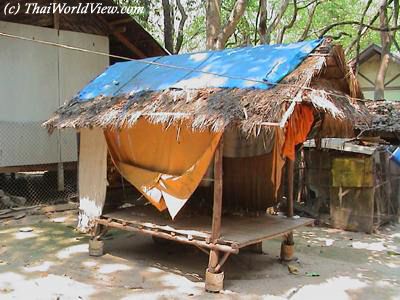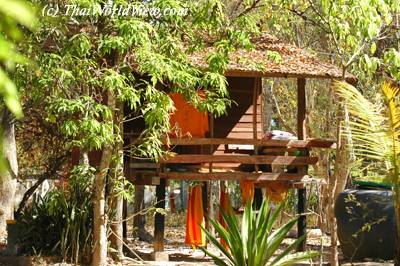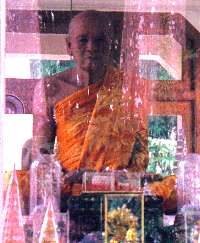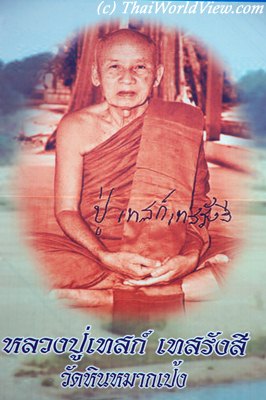FOREST MONKS
Increase or decrease font size for easier reading : A+ A-
Many famous Buddhist priests are monks who are living in the forest. This way of life is called forest way. The monks ( "PHRA" - พระ) living in the forest are called "PHRA THUDONG" (พระธุดงค์).

The forest way is a way of life coming from the "ISAN" area (อีสาน - northeastern part of Thailand). Thanks to these temples in the forest, some parts of the Thai forest were protected.

They sometimes sleep in Buddhist sanctuaries like caves. Of course they stay in a temple during the rain retreat. They imposed themselves stricter rules. They usually eat only one meal per day. When they sleep, they sleep in the meditation position.

When walking, they are of course confronted to bad weather such as storms, big rains. When wandering through forests or jungles they sleep in temples or use their net to protect themselves against mosquitoes. When walking a long time, sometimes feet hurt and it became very difficult to walk through the jungle. Despite the heat and humidity inside the Thai jungle or forests, these monks still manage to concentrate and meditate. They are also confronted to diseases like malaria.
One famous forest monk is Phra Achan Lee (1907-1961). The story of his life is very interesting. He has been to Cambodia to discover Angkor, to Burma to discover the famous Schwedagon pagoda and to India to discover the places where Buddha has lived. Having been a monk for several years, he began to have doubts and then left the monkshood. He then married a Thai woman, had children. Back in everyday life, he was confronted with many problems, so he decided to come back to monkshood. He was a monk again till his death. He had organised a big fair for the 2500th Buddhism birthday in 1957.

Nowadays, the forest monk's worst threat does not come from wild animals but from loggers, poachers and soldiers. Wandering monks believed that tigers, wild elephants and snakes were guardian spirits that have disguised themselves in order to test the monks' real understanding and faith.
Thai people pretend that when meditating, Phra Achan Lee reached different levels of concentration and was able to command mosquitoes not to bite him and tigers not to attack him.
Phra Achan Tet (1902-1994) was the abbot of "WAT HIN MAAK PENG", famous royal temple in Isan area near the town of Sri Chiang Mai. As a forest monk he travelled a lot. Eighty years ago travelling was very long and dangerous. Thieves were numerous and police not very efficient. Only rich people could travel quite fast and with many belongings thanks to the use of elephants.

The forest monks have a mosquito net to protect themselves while meditating or sleeping in the forests or jungles. Phra Achan Tet did stay several rain retreats in hill tribes. Looking for calm, solitude he was hoping that hill tribes people wouldn't bother him due to language barriers. On the opposite he became the village attraction because in 1930's he was one of the first monk to stay during a rain retreat in a hill tribe village. The forest monks are confronted to the problem to find their food every morning. In remote area it was not always easy to find Buddhists villagers.

In year 2008, wild elephants killed one Buddhist monk and seriously injured another in Thap Lan national park in Nakhon Ratchasima province. The two were members of a group of 11 monks who had gone to meditate in Khon Buri forest reserve, within the park boundaries. It was likely the herd attacked the monks because they feared for the safety of their young.

Then Phra Achan Tet stayed about fifteen years in the Phuket area. He received many religious awards there. But finally as a true forest monk, he resigned of all his religious positions and came back in Isan. He decided to settle in "WAT HIN MAAK PENG". Due to the presence of Phra Achan Tet, "WAT HIN MAAK PENG" is now a big temple with royal distinctions. It is a colorful temple with many buildings thanks to the money given by devotees. Money given to Phra Achan Tet was also used to improve other temples building in Nongkhai district and also schools and hospitals.

comments powered by Disqus


